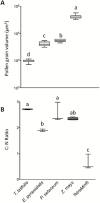Grass Pollen Affects Survival and Development of Larval Anopheles arabiensis (Diptera: Culicidae)
- PMID: 28922900
- PMCID: PMC5597869
- DOI: 10.1093/jisesa/iex067
Grass Pollen Affects Survival and Development of Larval Anopheles arabiensis (Diptera: Culicidae)
Abstract
Nutrients in breeding sites are critical for the survival and development of malaria mosquitoes, having a direct impact on vectorial capacity. Yet, there is a limited understanding about the natural larval diet and its impact on the individual fitness of mosquitoes. Recent studies have shown that gravid Anopheles arabiensis Patton (Diptera: Culicidae) are attracted by and oviposit in grass-associated habitats. The pollen provided by these grasses is a potential source of nutrients for the larvae. Here, we assess the effect of Typha latifolia L. (Poales: Typhaceae), Echinochloa pyramidalis Lamarck, Pennisetum setaceum Forsskål, and Zea mays L. pollen on larval survival and rate of development in An. arabiensis under laboratory conditions. In addition, we characterize the carbon to nitrogen ratio and the size of pollen grains as a measure of diet quality. Carbon-rich pollen with a small grain size (T. latifolia and P. setaceum; 9.7 ± 0.3 × 103 and 5.5 ± 0.2 × 104 µm3, respectively) resulted in enhanced rates of development of An. arabiensis. In contrast, the larva fed on the nitrogen-rich control diet (TetraMin) was slower to develop, but demonstrated the highest larval survival. Larvae fed on carbon-rich and large-grained Z. mays pollen (4.1 ± 0.2 × 105 µm3) survived at similar levels as those fed on the control diet and also took a longer time to develop compared with larvae fed on the other pollens. While males and females did not appear to develop differently on the different pollen diets, males consistently emerged faster than their female counterparts. These results are discussed in relation to integrated vector management.
Keywords: Carbon to nitrogen ratio; malaria; mosquito; nutrient; pollen grain.
© The Author 2017. Published by Oxford University Press on behalf of Entomological Society of America.
Figures




Similar articles
-
The role of grass volatiles on oviposition site selection by Anopheles arabiensis and Anopheles coluzzii.Malar J. 2017 Feb 7;16(1):65. doi: 10.1186/s12936-017-1717-z. Malar J. 2017. PMID: 28173804 Free PMC article.
-
Effect of Microsporidia MB infection on the development and fitness of Anopheles arabiensis under different diet regimes.Parasit Vectors. 2024 Jul 9;17(1):294. doi: 10.1186/s13071-024-06365-8. Parasit Vectors. 2024. PMID: 38982472 Free PMC article.
-
Maize pollen diet enhances malaria mosquito longevity and infectivity to Plasmodium parasites in Ethiopia.Sci Rep. 2023 Sep 2;13(1):14490. doi: 10.1038/s41598-023-41826-7. Sci Rep. 2023. PMID: 37660195 Free PMC article.
-
A(maize)ing attraction: gravid Anopheles arabiensis are attracted and oviposit in response to maize pollen odours.Malar J. 2017 Jan 23;16(1):39. doi: 10.1186/s12936-016-1656-0. Malar J. 2017. PMID: 28114992 Free PMC article.
-
Contributions of Anopheles larval control to malaria suppression in tropical Africa: review of achievements and potential.Med Vet Entomol. 2007 Mar;21(1):2-21. doi: 10.1111/j.1365-2915.2007.00674.x. Med Vet Entomol. 2007. PMID: 17373942 Review.
Cited by
-
Grass-like plants release general volatile cues attractive for gravid Anopheles gambiae sensu stricto mosquitoes.Parasit Vectors. 2021 Oct 27;14(1):552. doi: 10.1186/s13071-021-04939-4. Parasit Vectors. 2021. PMID: 34706760 Free PMC article.
-
Sweet attraction: sugarcane pollen-associated volatiles attract gravid Anopheles arabiensis.Malar J. 2018 Feb 21;17(1):90. doi: 10.1186/s12936-018-2245-1. Malar J. 2018. PMID: 29466989 Free PMC article.
-
Insect chemical ecology: chemically mediated interactions and novel applications in agriculture.Arthropod Plant Interact. 2020;14(6):671-684. doi: 10.1007/s11829-020-09791-4. Epub 2020 Nov 9. Arthropod Plant Interact. 2020. PMID: 33193908 Free PMC article.
-
Synthetic Alfalfa Infusion Odour Attracts Gravid Culex quinquefasciatus Under Laboratory Conditions.J Chem Ecol. 2024 Oct;50(9-10):419-429. doi: 10.1007/s10886-024-01528-4. Epub 2024 Jul 13. J Chem Ecol. 2024. PMID: 39001967 Free PMC article.
-
Root exudate chemical cues of an invasive plant modulate oviposition behavior and survivorship of a malaria mosquito vector.Sci Rep. 2021 Jul 20;11(1):14785. doi: 10.1038/s41598-021-94043-5. Sci Rep. 2021. PMID: 34285252 Free PMC article.
References
-
- Ameneshewa B., and Service M. W.. 1996. The relationship between female body size and survival rate of the malaria vector Anopheles arabiensis in Ethiopia. Med. Vet. Entomol. 10: 170–172. - PubMed
-
- Baird M. E., and Middleton J. H.. 2004. On relating physical limits to the carbon: nitrogen ratio of unicellular algae and benthic plants. J. Marine Syst. 49: 169–175.
-
- Bøgh C., Clarke S. E., Jawara M., Thomas C. J., and Lindsay S. W.. 2003. Localized breeding of the Anopheles gambiae complex (Diptera: Culicidae) along the River Gambia, West Africa. Bull. Entomol. Res. 93: 279–287. - PubMed
MeSH terms
LinkOut - more resources
Full Text Sources
Other Literature Sources

